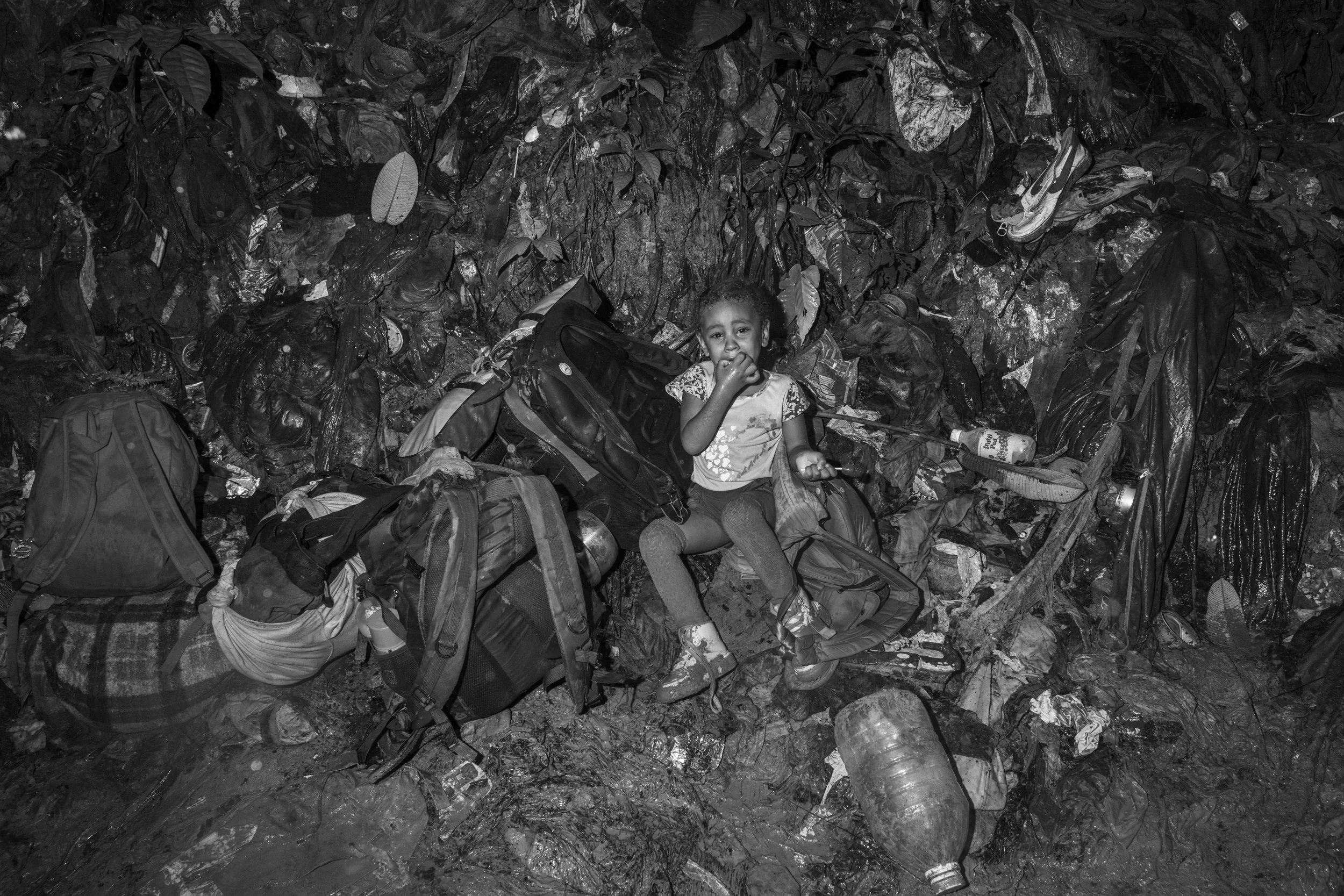
MALDITO DARIEN
The Darién Gap is a dense and treacherous jungle corridor between Colombia and Panama that has become the most dangerous land route for migrants heading toward the United States. Once considered nearly impassable, this roughly 66-mile stretch of rainforest has evolved into a major migration artery. In recent years, hundreds of thousands of people have braved this passage.
But the numbers now tell a dramatic story of collapse. Data from early 2025 show that between January and March only about 2,800 migrants crossed the Darién — a drop of more than 98% compared to previous years. This sudden decline reflects more than geography; it marks a profound shift in policy and deterrence strategy.
Migrants from Venezuela, Haiti, Ecuador, and increasingly from Africa, Asia, and the Middle East have used this passage to escape violence, poverty, and political upheaval. They face unimaginable risks: nearly impassable rivers, flooding, wild animals, tropical diseases, armed bandits, sexual violence, and disappearance.
Today, however, the journey north continues only in fits and starts. Under stricter enforcement measures introduced by the Trump administration and new cooperation agreements with countries such as Panama and Mexico, migrants are being blocked, detained, or returned before they reach Central America. Camps in the Darién that once teemed with thousands each day now sit nearly empty.
This dramatic drop has left thousands of families stranded in limbo — caught between the jungle they survived, the obstacles ahead, and the walls of policy that now stand in their way..
A Venezuelan migrant carrying his sleeping son while trekking uphill through the challenging terrain of the Darien jungle on the second day of their journey, seeking to cross the border into Panama.
A man sells water and drinks to migrants along the Darién Gap trek in Colombia, holding U.S. dollar bills. The area is controlled by the Gulf Clan, an armed group that oversees crossings and regulates trade along the route.
Over 2,000 migrants from Venezuela, Colombia, Ecuador, and Haiti assembled early morning at the Las Tecas camp, poised to embark on a journey through the Darien jungle.
Clothing hung out to dry on a tree by migrants camping on the beach in Necocli, Colombia.
César Ramírez (37) and Wilmer Alexis Ramírez (37), twin brothers from Colombia, on the beach of Necoclí, where they’ve been stranded for two months, saving money to cross the Darién Gap toward the United States.
A Venezuelan migrant family camping on Necocli Beach, Colombia, awaiting funds to travel by boat to Acandi and initiate the Darien crossing.
More than 2,000 migrants from Venezuela, Colombia, Ecuador, and Haiti commence their journey through the Darien jungle from Las Tecas camp following its opening
A Venezuelan migrant trekking through the Darien Gap barefoot in muddy conditions, along Pata de la Ioma hill in Colombia.
A young Venezuelan girl covered in mud after trekking for approximately 7 hours through the Darien Gap
Exhausted migrants reached the hilltop where the Descansadero 4th base is located after approximately 10 hours of hiking through the Darien Gap in Colombia.
Migrants departing early in the morning from Descansadero 4th base to commence the second day of trekking through the Darien Gap, aiming to cross the border into Panama.
A man carrying empty water bottles uphill in the Darien jungle.
An exhausted Venezuelan woman collapses on the muddy ground as her one-year-old son breastfeeds on his own, after hours of trekking through the treacherous Darién jungle near the border with Panama.
A group of exhausted migrants descends a muddy hill after crossing the border into Panama through the Darién jungle. Known as 'the Hill of Death,' this section of the journey is one of the most feared, made even more treacherous by heavy rain transforming the terrain into a canyon of mud.
Migrants cross a river in the Darién jungle, Panama, under heavy rain. Strong currents and frequent floods make this stretch of the journey particularly perilous. The rainy season heightens the dangers of river crossings, and many deaths in the jungle are caused by drowning.
A five-year-old Venezuelan girl cries in the rain on the Panamanian side of the Darién jungle, surrounded by the waste left behind by migrants. From January to November 2024, over 60,000 children have crossed the Darién, 37% of whom are aged 0-5. Nearly 4,500 of these children traveled unaccompanied or separated, a significant increase compared to previous years.
Ecuadorian and Venezuelan migrant families climbing slippery rock cliffs during a river trek through the Darien jungle in Panama.
Migrants navigating strong currents in a river, swollen by heavy rainfall, during their crossing of the Darien Jungle in Panama.
A Venezuelan migrant with a broken leg after falling into a river during the trek. Stranded without food or help in a makeshift riverside camp, she was rescued days later by Senafron agents.
Venezuelan migrant Jocelyn Anei, 40, collapses from exhaustion next to her seven-month-old son, Santiago, in an improvised camp in the Darién jungle, Panama. After losing her bag during a river crossing and going without food for five days, she endured extreme humidity and blisters on her feet. Despite being exhausted and struggling with fatigue, she faced the harsh conditions of the jungle while caring for her son alone.
The body of a young migrant discovered deceased inside a tent along the river in the Darien jungle of Panama.
Vegetation in the Darien Jungle, early morning after a prolonged period of heavy rainfall.
Migrants crossing the Darien Jungle in Panama, on the fifth day of their trek.
The body of a man, wrapped in plastic bags, is found along a river as migrants traverse the Darién jungle in Panama. Between January 2021 and April 2023, at least 124 bodies of people who died attempting to cross the Darién were discovered, according to estimates from the Panamanian government reported by Human Rights Watch. This number, however, may be far lower than the reality, as Panamanian and Colombian authorities rarely intervene in the jungle, allowing criminal gangs and traffickers to operate with impunity. Most of the deaths are attributed to drownings and accidents.
Migrants join hands to cross a river against strong currents.
A young girl embraces and kisses her exhausted mother at the end of their journey through the Darién Gap, near the point where small boats transport migrants to Bajo Chiquito, Panama, offering them assistance and services. For those who survive the jungle, the journey continues, stretching 4,000 kilometers through Costa Rica, Nicaragua, Honduras or El Salvador, Guatemala, and Mexico before reaching the United States.


























